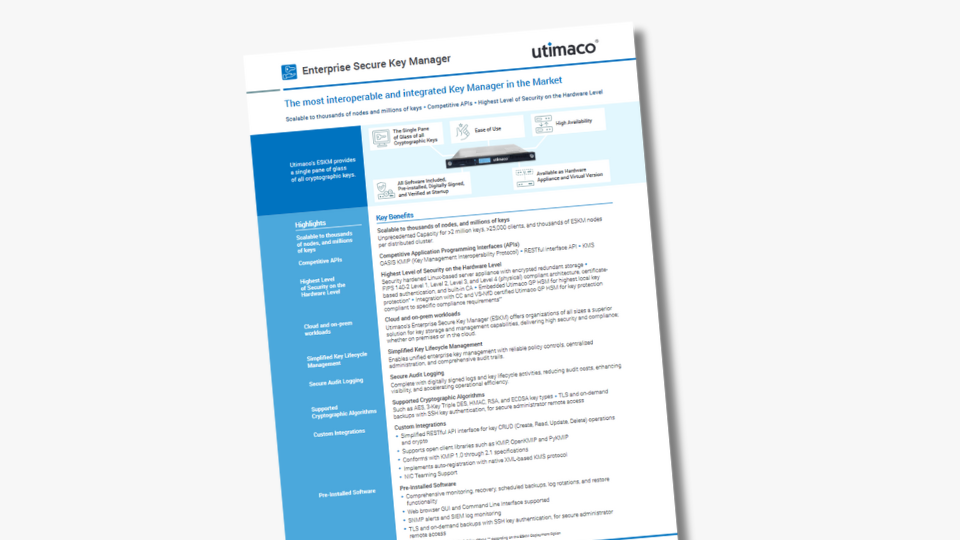A full 70% of all workloads are in the cloud, with 81% of organizations using multiple cloud providers and 75% adopting a digital transformation strategy based on the cloud. The petabytes upon petabytes of data being stored in the cloud all need to be secured, and the gold standard for data security is encryption utilizing cryptographic keys. But encrypting data might not be enough for ensuring reliable protection of cloud-stored data and cloud-utilized applications.There are of course some intricacies that companies need to consider.
Let’s explore the critical concept of key migration and management in the cloud, focusing on Bring Your Own Key (BYOK), Control Your Own Key (CYOK), and Hold Your Own Key (HYOK) strategies. Understanding these methods is essential for deciding on the right Key Management Solution, to ensure control and security over your sensitive data in the cloud.
If you want to learn more about safe cloud migration, watch our webinar!

What are Bring Your Own Key, Control Your Own Key, and Hold Your Own Key?
There are three ways that your company can use cryptographic keys with a cloud security setup, all with their own distinct advantages and disadvantages:
Bring Your Own Key (BYOK)
BYOK allows organizations to generate their own encryption keys which are used by the cloud service provider (CSP) to encrypt and decrypt the customer’s data. The management of the keys is done on the customers end, ensuring a higher level of security compared to using a key from the CSP’s own key management system. The primary advantage of BYOK is control—organizations maintain the ability to generate, manage, and revoke keys as needed. This reduces dependency on the CSP and can enhance trust, as the organization knows exactly how keys are handled. For additional security of the key, it is recommended to use a Hardware Security Module (HSM) for the creation and storage of the keys.
However, BYOK has its drawbacks. While the keys are being uploaded to the cloud, there is the risk for them to be retrieved and compromised. Furthermore, there might be the possibility for the CSP to generate a kind of a master key for the used encryption method. While BYOK enhances control, the CSP still has potential access to these keys, posing a potential risk if the CSP is compromised.
Control Your Own Key (CYOK)
CYOK takes BYOK a step further. In this model, the organization also brings its own keys but never uploads them to the CSP’s systems. The advantages here are maximal control and security. This reduces the risk of compromise from the provider's end as the user keeps full control over the key lifecycle and can revoke them at any time, if needed. Regarding their storage the keys in the CYOK model can be held in a specific virtual node within the cloud or an on-premises setup.
The primary disadvantage of CYOK is the significant responsibility it places on the organization. Effective CYOK implementation requires robust infrastructure and expertise in key management. Failure to properly manage and protect these keys can lead to severe security breaches.
Hold Your Own Key (HYOK)
HYOK offers the highest level of protection and control. In this model, organizations keep their encryption keys on-premises, ideally stored in an HSMs, never allowing them to leave their premises. The encryption of the data is carried out before the data is uploaded to the cloud. Also the decryption of the data is done on-premises after their download from the cloud. The CSP in this model does not have access to the keys at any point. HYOK is particularly appealing for highly regulated industries or any organization with stringent security requirements.
The downside of HYOK is the complexity and cost. Implementing and maintaining the necessary infrastructure can be resource intensive. Moreover, the organization bears full responsibility for key management, including disaster recovery and key rotation, which can be challenging.
Should you rely on a cloud service provider's Key Management solutions?
Relying on a CSP’s key management solutions might look convenient and secure. Especially for organizations planning to migrate to the cloud this seems to be an option making it easier to take the first step. But it can expose organizations to several risks. First, it creates a single point of failure: if the CSP's security is compromised, your keys—and by extension, your data—are at risk. Using the CSP's key management solutions means to store the encrypted data in the same location as the keys to encrypt the data which is against standards to ensure highest security. You also are depending on the CSP for updating your keys and implementing new cryptographic standards.
By employing your own key management system (KMS), you significantly mitigate these risks. An independent KMS ensures that you retain full control over your keys and manage them in a transparent way through one single pane of glass; independent of their usage (may it be in the private cloud or public cloud setups including multi-cloud models. The integration with an HSM for generation and storage of high-quality cryptographic keys can significantly enhance the security of your data as well as your whole digital infrastructure. Your KMS can be designed to meet your specific security requirements, including multi-factor authentication, detailed logging, and customizable key rotation policies.
Moreover, an independent KMS enables compliance with regulatory standards that may mandate stringent data protection measures. It also ensures continuity and control during CSP migrations or in multi-cloud environments, providing a consistent security posture regardless of the underlying infrastructure.
Enhancing security to ensure operational resilience
Migrating to the cloud is a strategic move that requires careful consideration of data security practices. Understanding and implementing effective key management strategies such as BYOK, CYOK, and HYOK is crucial for maintaining control over your data. While each approach has its advantages and challenges, the fundamental principle is clear: do not rely solely on your CSP for key management.
Implementing your own robust KMS not only enhances security but also ensures compliance and operational resilience. At Utimaco, we are committed to providing the tools and expertise needed to navigate the complexities of cloud security and key management, empowering your organization to leverage the cloud with confidence.
If you want to learn more about safe cloud migration, watch our webinar!








